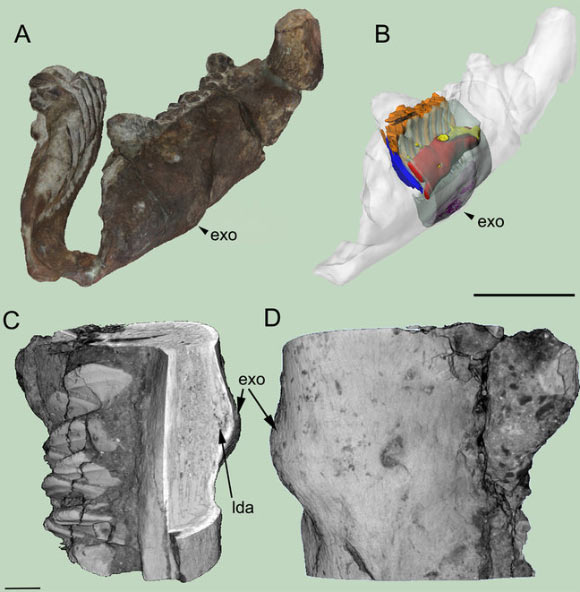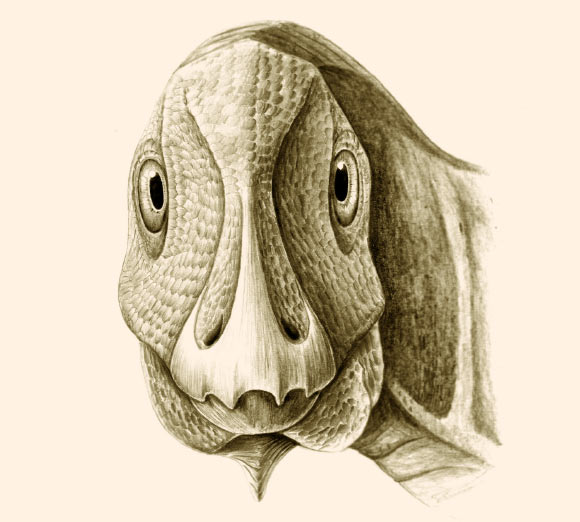@ WFS,World Fossil Society,Riffin T Sajeev,Russel T Sajeev
The dinosaur fossil, estimated to be 69-67 million years old (Cretaceous period), was discovered in an outcrop of the Sinpetru Formation along the banks of the Sibisel River, in the Haţeg County Dinosaurs Geopark, western Romania.
The specimen is represented by a pair of well-preserved, associated lower jaws belonging to a sub-adult individual of the hadrosauroid dinosaurTelmatosaurus transsylvanicus.
It provides the first evidence of a pathological condition previously unrecognized in the dinosaurian fossil record.

Structure of the pathological Telmatosaurus transsylvanicus dentary: (A) – surface scans of the left and right rami positioned in anatomical articulation; (B) – segmented internal structures of the left ramus exhibiting the pathology (red – primary neurovascular canal, yellow – secondary neurovascular pathways, orange – functional teeth, blue – replacement teeth, light blue – segmented dentary bone, purple – lytic density areas); (C) – 3D micro-CT image with rectangular cutout in the area of the exostosis; (D) 3D micro-CT image of the investigated portion of the dentary showing the external appearance of the exostosis. Scale bars: (A,B) – 50 mm; (C-D) – 5 mm. Image credit: Mihai D. Dumbrava et al.
“This discovery is the first ever described in the fossil record and the first to be thoroughly documented in a dwarf dinosaur,” said Katharine Acheson, a PhD student at the University of Southampton and co-author of the study, published in the journal Scientific Reports.
“Telmatosaurus is known to be close to the root of the duck-billed dinosaur family tree, and the presence of such a deformity early in their evolution provides us with further evidence that the duck-billed dinosaurs were more prone to tumors than other dinosaurs.”
“It was obvious that the fossil was deformed when it was found more than a decade ago but what caused the outgrowth remained unclear until now,” said co-author Dr. Zoltán Csiki-Sava, from the University of Bucharest, Romania.
It is unlikely that the tumor caused the dinosaur any serious pain during its early stages of development, just as in humans with the same condition, but the paleontologists can tell from its size that this particular dinosaur died before it reached adulthood.
“We know from modern examples that predators often attack a member of the herd that looks a little different or is even slightly disabled by a disease,” Dr. Csiki-Sava said.

Artistic reconstruction of the pathological individual of the hadrosauroid dinosaur Telmatosaurus transsylvanicus from the uppermost Cretaceous of the Hateg Basin, Romania, in rostral view, showing the probable life appearance of the mandibular deformity caused by ameloblastoma. Image credit: Mihai D. Dumbrava.
“The tumor in this dinosaur had not developed to its full extent at the moment it died, but it could have indirectly contributed to its early demise.”
“The particular make-up of the rocks allowed us to identify that this fossil was preserved near the channel of an ancient river,” Acheson added.
“In a setting like this, it is extremely rare to find the complete specimen, and so it is almost impossible to determine the specific cause of death. One can only make an informed guess based upon the evidence we have.”
“The discovery of an ameloblastoma in a duck-billed dinosaur documents that we have more in common with dinosaurs than previously realized,” said co-author Dr. Bruce Rothschild, from the Northeast Ohio Medical University.
Citation: Mihai D. Dumbravă et al. 2016. A dinosaurian facial deformity and the first occurrence of ameloblastoma in the fossil record. Scientific Reports 6, article number: 29271; doi: 10.1038/srep29271
Courtesy: SCI News.com



 July 6th, 2016
July 6th, 2016  Riffin
Riffin  Posted in
Posted in  Tags:
Tags: 